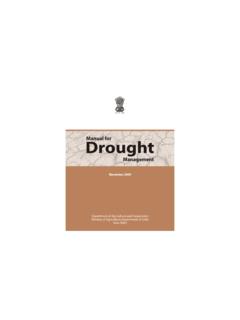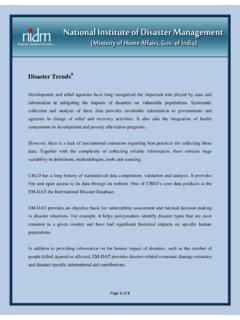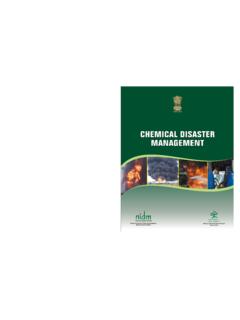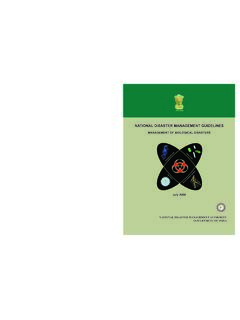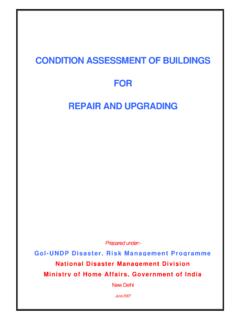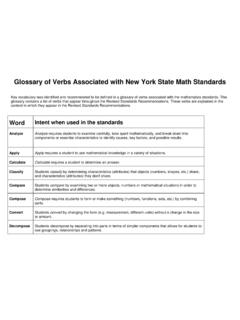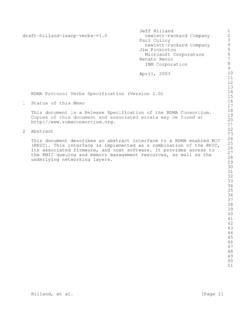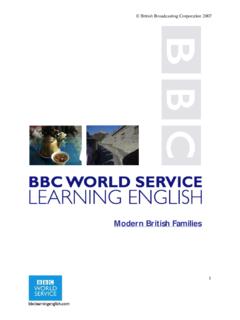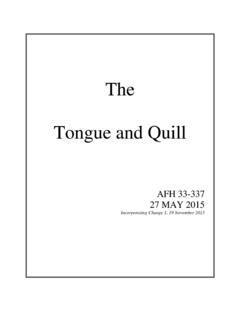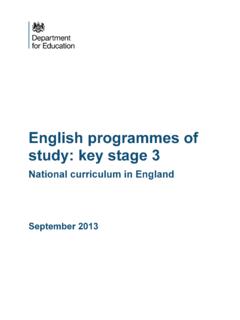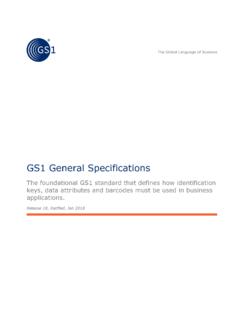Transcription of Training of Trainers Module for Teachers on …
1 Training of Trainers Module for Teachers on Creation of culture of safety through knowledge and education SEEDS Technical Services- knowledge Links 1 Training of Trainers Module for Teachers on Creation of culture of safety through knowledge and education Part of Deliverable 12 16 July 2014 Training of Trainers Module for Teachers on Creation of culture of safety through knowledge and education SEEDS Technical Services- knowledge Links i Contents Abbreviations and Acronyms .. iii Glossary .. iv Introduction .. 1 Context .. 1 About the Training Module .. 2 Sub-Modules and Learning Units .. 3 Training Schedule .. 5 Guidance Note for Trainers and facilitators.
2 7 Opening the course .. 8 Concurrent and End-of- Module feedback from participants .. 10 LEARNING UNIT 1: DISASTER RISK REDUCTION (DRR) AND culture OF safety AN OVERVIEW .. 11 Session : Disaster risk reduction (DRR) and culture of safety : an overview .. 12 Session : Concepts of hazard, risk vulnerability and capacity .. 16 Session : Disaster management cycle: stages, issues and challenges .. 20 LEARNING UNIT 2: ROLE OF education IN DISASTER RISK REDUCTION (DRR) .. 24 Session : Role of education in creating awareness of disaster risks .. 25 Session : Disaster Risk Reduction (DRR) in Schools .. 30 LEARNING UNIT 3: ROLE OF SCHOOLS IN DISASTER PREVENTION AND PREPAREDNESS.
3 34 Session : Disaster prevention: with a focus on school safety and the safety of the larger community.. 35 Session : Disaster prevention and preparedness: how to get most out of the formal curriculum? .. 38 Session : Co-curricular/extra-curricular activities for improved disaster prevention and preparedness .. 42 LEARNING UNIT 4: SCHOOL-BASED DISASTER PREPAREDNESS: VALUES, PRINCIPLES AND PARAMETERS .. 46 Session : School based disaster preparedness: an overview .. 47 Session : Parameters for School Based Disaster Preparedness .. 51 Session : Development of School-Based Disaster Preparedness: Values and Principles 55 LEARNING UNIT 5: SYSTEMATIC APPROACH TO Training (SAT).
4 59 Session : Systematic Approach to Training (SAT) and Assessing Training Needs .. 60 Session : Defining Training Aim and Objectives .. 64 Training of Trainers Module for Teachers on Creation of culture of safety through knowledge and education SEEDS Technical Services- knowledge Links ii Session : Deciding the content, methodology and resource persons .. 67 Session : Deciding the monitoring and evaluation indicators and 70 LEARNING UNIT 6: LEARNING AND FACILITATION SKILLS .. 73 Session : Art of Facilitation I .. 74 Session : Art of Facilitation II .. 77 Session : Sharing, Listening and Learning .. 81 Session : Learning to listen and listening to learn.
5 84 ANNEXURE 1: HANDOUTS .. 87 Handout 1: Hyogo Framework for Action 2005-2015: Building the Resilience of Nations and Communities to Disaster .. 87 Handout 2: Scope of DRR Curricula .. 87 Handout 3: Four Indicative Examples of Learning Outcomes Progression .. 88 Handout 4 : Cyclone AILA hits Sundarbans--Case Study .. 88 Handout 5: Comprehensive School safety Scheme .. 91 Handout 6: Teaching and learning Disaster Prevention .. 92 Handout 7: Appropriate Learning Modalities for Disaster Risk Reduction education .. 93 Handout 8: Good Practices: Disaster Prevention and Preparedness through Extra-Curricular education .. 93 Handout 9: Example of School Disaster Management Checklist.
6 95 Handout 10: Milestones for School Disaster Management Plan .. 96 Handout 11: Systematic Approach to Training .. 96 Handout 12: Capacity Needs and Training Needs Assessment .. 98 Handout 13: Training /Behavioural Objectives: Verbs to Describe Complexity of Behaviour .. 100 Handout 14: Johari Window .. 101 Handout 15: Stephen Covey s seven habits of highly effective people .. 102 ANNEXURE 2: DESIGN BRIEF .. 103 Sources, References and Further Readings .. 114 Training of Trainers Module for Teachers on Creation of culture of safety through knowledge and education SEEDS Technical Services- knowledge Links iii Abbreviations and Acronyms BRI : Building Research Institute CCA : Climate Change Adaptation DMCs : Disaster Management Centres DRR : Disaster Risk Reduction DRRE : Disaster Risk Reduction education Eos : Enabling Objectives GOI : Government of India GRIPS : The National Graduate Institute for Policy Studies HFA : Hyogo Framework for Action IFRC : International Federation of Red Cross and Red Crescent Societies IPCC : The Inter-governmental Panel on Climate Change KSA.
7 knowledge , Skills and Attitude MDGs : Millennium Development Goals NCRMP : National Cyclone Risk Mitigation Project NIDM : National Institute of Disaster Management Pos : Performance Objectives SAT : Systematic Approach to Training SFIT : Strategic Framework for Implementation of Training SMART : Specific, Measurable, Attainable, Realistic and Time bound SOP : Standard Operation Procedures SOWT : Strength Opportunity Weakness Threat TOs : Training Objectives TOT : Training Of Trainers UNFCCC : The United Nations Framework Convention on Climate Change UNISDR : The United Nations International Strategy for Disaster Reduction VANE : Values, Attitudes, Needs and Expectations VANI : Values, Assumptions, Needs and Interests Training of Trainers Module for Teachers on Creation of culture of safety through knowledge and education SEEDS Technical Services- knowledge Links iv Glossary Basic terms of disaster risk reduction (DRR), UNISDR (2009) Acceptable risk: The level of potential losses that a society or community considers acceptable given existing social, economic, political, cultural, technical and environmental conditions.
8 Adaptation: The adjustment in natural or human systems in response to actual or expected climatic stimuli or their effects, which moderates harm or exploits beneficial opportunities. Biological hazard: Process or phenomenon of organic origin or conveyed by biological vectors, including exposure to pathogenic micro-organisms, toxins and bioactive substances that may cause loss of life, injury, illness or other health impacts, property damage, loss of livelihoods and services, social and economic disruption, or environmental damage. Building code: A set of ordinances or regulations and associated standards intended to control aspects of the design, construction, materials, alteration and occupancy of structures that are necessary to ensure human safety and welfare, including resistance to collapse and damage.
9 Capacity: The combination of all the strengths, attributes and resources available within a community, society or organization that can be used to achieve agreed goals. Capacity Development: The process by which people, organizations and society systematically stimulate and develop their capacities over time to achieve social and economic goals, including through improvement of knowledge , skills, systems, and institutions. Climate change: (a) The Inter-governmental Panel on Climate Change (IPCC) defines climate change as: a change in the state of the climate that can be identified ( , by using statistical tests) by changes in the mean and/or the variability of its properties, and that persists for an extended period, typically decades or longer.
10 Climate change may be due to natural internal processes or external forcing or to persistent anthropogenic changes in the composition of the atmosphere or in land use . (b) The United Nations Framework Convention on Climate Change (UNFCCC) defines climate change as a change of climate which is attributed directly or indirectly to human activity that alters the composition of the global atmosphere and which is in addition to natural climate variability observed over comparable time periods. Contingency planning: A management process that analyses specific potential events or emerging situations that might threaten society or the environment and establishes arrangements in advance to enable timely, effective and appropriate responses to such events and situations.

